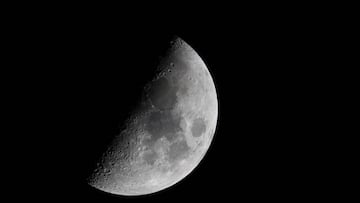Double crater appears on the moon after the mysterious impact of a rocket
NASA’s LRO orbiter has found a 60-foot crater superimposed on a 52-foot crater, along with the remains of the unknown rocket that hit the lunar surface in March.

NASA’s Lunar Reconnaissance Orbiter (LRO), the US space probe sent to explore the Moon, launched in June 2009, has overflown the impact site of a rocket that crashed into the far side of Earth’s only natural satellite in March.
In the area, the LRO found a 60-foot (18-meter) hole, superimposed on another 52-foot (16-meter) hole. The presence of this double crater has taken astronomers by surprise. The origin of the rocket that hit the moon in March is still unknown. According to LRO orbiter lead team principal investigator Mark Robinson, one explanation is that the rocket that slammed into the lunar surface had a large amount of mass spread unevenly throughout its body.
“Usually a spent rocket has mass concentrated at the end where the engine is; the rest of the rocket stage consists mainly of an empty fuel tank. This double crater suggests the existence of a large amount of mass at both ends [of the rocket] when it hit the Moon,” Robinson said. NASA sources said, “no other rocket body impact on the Moon” has created a double crater on previous occasions.
Robinson also noted that the four craters caused by crashing the Apollo SIV-B (the Saturn V’s third stage) into the moon, “were somewhat irregular in outline.” The third stages of Apollo 13, 14, 15, 17 were crashed into the moon to perform seismic measurements. “The maximum width (29 meters) of the double crater of the mysterious rocket body was close to that of the S-IVB.”
Since its arrival in orbit around the moon in 2009, the RLO has compiled a treasure trove of data with its seven powerful instruments, making an incalculable contribution to our knowledge of the Moon, as NASA said in its official statement.
However, the RLO data has not been able to solve the controversy over the origin of the rocket that hit the moon.
China denies that the rocket was launched by them
Initial suspicions were that SpaceX was responsible for the rocket that hit the moon in question, specifically the upper stage of a Falcon 9 rocket that Elon Musk’s company launched to put the Deep Space Climate satellite into orbit. However NASA verified that the orbit of the rocket that crashed into the lunar surface did not coincide with that of SpaceX.
Different analyzes carried out in the United States point to China as the source of the rocket. “It’s more like the orbit of the upper stage of the rocket that launched China’s Chang’e 5-T1 mission in 2014,” said Bill Gray, an astronomer who heads the Pluto program for Project, tracking distant space objects. However, China denies it was their rocket. A spokesman for the Ministry of Foreign Affairs, Wang Wenbin said: “According to China’s monitoring, the upper stage of the mission-related rocket entered the Earth’s atmosphere and burned up completely.”





